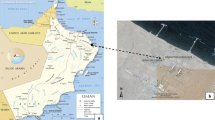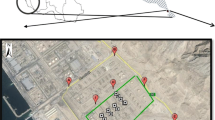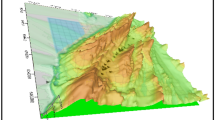Abstract
Air quality modeling can be considered as a useful tool to predict air quality in the future and determine the control strategies of emissions abatement. In this study, the AERMOD dispersion model has been applied as a tool for the analysis of the values of pollutant emissions from the flares of the Maroon gas refinery located in the suburb of Ahvaz, Iran. First, the values of pollutant emissions from the refinery’s flares were investigated by measurement and using the emission factors during cold and warm seasons of 2018. The gas burns continuously in two flares and the other 11 flares are used in emergency situations and only their spark plugs are lit. The type of compounds and their molar, volumetric, and weight percentages were determined by gas chromatography (GC) injection. By entering data such as emission rate, flare characteristics, and topographic and meteorological data of the study area into the AERMOD model, dispersion of pollutants was predicted by using the AERMOD model in the region with an area of 2500 km2. The statistical evaluation showed that the maximum 8-h concentration of CO in the cold season was 133441 μg/m3 which was higher than the standard and reached 9755 μg/m3 in the warm season that was close to the standard. The maximum hourly concentration of SO2 was in the cold season with 215 μg/m3 that was higher than the standard value, occurred in a local scale of 50 km2. This can be attributed to the high concentration of SO2 wet deposition. According to the direction of the wind from the northwest, pollutant emissions can lead to adverse health effects on the population of refinery employees, residents around the refinery, and occupants of passing vehicles. The concentration of pollutants generated due to the high volume of heavier compounds in the gas in the winter season was higher than that of the warm season. Comparison of maximum concentrations of the predicted results with the national and international standards showed that SO2 and CO concentration is higher than standard values. In total, according to the evaluation of the predictions made, the performance of the AERMOD model was acceptable in the prediction of pollutant concentrations in the study area.





Similar content being viewed by others
Data Availability
“Not applicable” for that specific section.
References
Amoatey P, Omidvarborna H, Affum HA, Baawain M (2019) Performance of AERMOD and CALPUFF models on SO2 and NO2 emissions for future health risk assessment in Tema Metropolis. Hum Ecol Risk Assess Int J 25(3):772–786
Baawain M, Al-Mamun A, Omidvarborna H, Al-Jabri A (2017) Assessment of hydrogen sulfide emission from a sewage treatment plant using AERMOD. Environ Monit Assess 189(6):263
Bigharaz M, Almassi Z, Abadi MN (2015) The simulation of dispersion and distribution of pollutants of flaring operation in refiners of South Pars through AERMOD. J Biodivrs Environ Sci 6:573–588
Boadh R, Satyanarayana ANV, Krishna SR (2014) Assessment of dispersion of oxide of nitrogen using AERMOD model over a tropical industrial region. Int J Comput Appl 90(11):43–50
Dastoorpoor M, Sekhavatpour Z, Masoumi K, Mohammadi MJ, Aghababaeian H, Khanjani N, Hashemzadeh B, Vahedian M (2019) Air pollution and hospital admissions for cardiovascular diseases in Ahvaz, Iran. Sci Total Environ 652:1318–1330
Davar H, Taghavirad SS, Mohammadi MJ (2014) The investigation of effects of silica on the environment and prevention of release of the silica particles with simulation of gas-solid flow in a gas cyclone. [Article]. Res J Chem Environ 18(11):28–30
Ding F (2012) Analysis of upper air environmental impact of pollutants discharged by power plant. Procedia Environ Sci 13:1149–1154
Faraji GF, Dobaradaran S, Saeedi R, Nabipour I, Nazmara S, Ranjbar VAD et al (2020) Levels and ecological and health risk assessment of PM2. 5-bound heavy metals in the northern part of the Persian Gulf. Environ Sci Pollut Res Int 27(5):5305–5313
Fawole OG, Cai X-M, MacKenzie A (2016) Gas flaring and resultant air pollution: a review focusing on black carbon. Environ Pollut 216:182–197
Fawole OG, Cai X, Abiye OE, MacKenzie A (2019) Dispersion of gas flaring emissions in the Niger delta: Impact of prevailing meteorological conditions and flare characteristics. Environ Pollut 246:284–293
Gibson MD, Kundu S, Satish M (2013) Dispersion model evaluation of PM2. 5, NOx and SO2 from point and major line sources in Nova Scotia, Canada using AERMOD Gaussian plume air dispersion model. Atmospheric Pollut Res 4(2):157–167
Hagan N, Robins N, Hsu-Kim H, Halabi S, Morris M, Woodall G, Zhang T, Bacon A, Richter DB, Vandenberg J (2011) Estimating historical atmospheric mercury concentrations from silver mining and their legacies in present-day surface soil in Potosí, Bolivia. Atmos Environ 45(40):7619–7626
Huertas JI, Huertas ME, Izquierdo S, González ED (2012) Air quality impact assessment of multiple open pit coal mines in northern Colombia. J Environ Manag 93(1):121–129
Karimi A, Shirmardi M, Hadei M, Birgani YT, Neisi A, Takdastan A, Goudarzi G (2019) Concentrations and health effects of short-and long-term exposure to PM2. 5, NO2, and O3 in ambient air of Ahvaz city, Iran (2014–2017). Ecotoxicol Environ Safe 180:542–548
Kesarkar AP, Dalvi M, Kaginalkar A, Ojha A (2007) Coupling of the Weather Research and Forecasting Model with AERMOD for pollutant dispersion modeling. A case study for PM10 dispersion over Pune, India. Atmos Environ 41(9):1976–1988
Ma J, Yi H, Tang X, Zhang Y, Xiang Y, Pu L (2013) Application of AERMOD on near future air quality simulation under the latest national emission control policy of China: a case study on an industrial city. J Environ Sci 25(8):1608–1617
Marzouni MB, Moradi M, Zarasvandi A, Akbaripoor S, Hassanvand MS, Neisi A, Barari K (2017) Health benefits of PM 10 reduction in Iran. Int J Biometeorol 61(8):1389–1401
McHugh C, Xiangyu S, Carruthers D (2005) Using ADMS models for air quality assessment and management in China. Chinese J Popul Resour Environ 3(3):3–10
Mirhoseini SH, Nikaeen M, Hatamzadeh M, Hassanzadeh A (2014) Assessment of bioaerosol concentration in the indoor environments. Health Syst Res 10(2):376–385
Mirrezaei MA, Orkomi AA (2020) Gas flares contribution in total health risk assessment of BTEX in Asalouyeh, Iran. Process Safety and Environmental Protection
Naghizadeh A, Sharifzadeh G, Tabatabaei F, Afzali A, Yari AR, Geravandi S, Mohammadi MJ (2019) Assessment of carbon monoxide concentration in indoor/outdoor air of Sarayan city, Khorasan Province of Iran. Environ Geochem Health 41(5):1875–1880
Pachauri RK, Reisinger A (2007) IPCC fourth assessment report. IPCC, Geneva, 2007
Perry, S. G., Cimorelli, A. J., Paine, R. J., Brode, R. W., Weil, J. C., Venkatram, A., Wilson R. B., Lee R. F., Peters W. D. (2005). AERMOD: A dispersion model for industrial source applications. Part II: Model performance against 17 field study databases.ss J Appl Meteorol, 44(5), 694–708.
Seangkiatiyuth K, Surapipith V, Tantrakarnapa K, Lothongkum AW (2011) Application of the AERMOD modeling system for environmental impact assessment of NO2 emissions from a cement complex. J Environ Sci 23(6):931–940
Shamsipour A, Ashrafi E, Alikhah AM, Ashrafi K (2016) Modeling the distribution of suspended particles in the south of Tehran by the model of AERMOD,(A Case Study of Tehran cement factory). J Environ Stud 41(4):799–814
Sharma N, Chaudhry K, Rao CC (2004) Vehicular pollution prediction modelling: a review of highway dispersion models. Transp Rev 24(4):409–435
Silverman KC, Tell JG, Sargent EV, Qiu Z (2007) Comparison of the industrial source complex and AERMOD dispersion models: case study for human health risk assessment. J Air Waste Manage Assoc 57(12):1439–1446
Zou B, Zhan FB, Wilson JG, Zeng Y (2010) Performance of AERMOD at different time scales. Simul Model Pract Theory 18(5):612–623
Acknowledgements
The authors acknowledge support from the Islamic Azad University, Ahvaz branch, Maroon Oil & Gas Production Company, Iran Meteorological Organizations, and National Iranian South Oil Company.
Funding
This work was financially supported by grant: (Ph.D thesis Seyed Sadegh Mousavi) from Islamic Azad University, Ahvaz branch.
Author information
Authors and Affiliations
Contributions
Study concept, design, and critical revision of the manuscript for important intellectual content: Seyed Sadegh Mousavi, Gholamreza Goudarzi, Sima Sabzalipour, Maryam Mohammadi Rouzbahani, Elham Mobarak Hassan; drafting of the manuscript and advisor: Seyed Sadegh Mousavi; performing the experiments: Seyed Sadegh Mousavi, Gholamreza Goudarzi; revised the manuscript and finalizing: Gholamreza Goudarzi, Seyed Sadegh Mousavi, and Maryam Mohammadi Rouzbahani.
Corresponding author
Ethics declarations
Ethical approval
This study was originally approved by the Islamic Azad University, Ahvaz branch Ph.D thesis of Seyed Sadegh Mousavi with code number 8663.
Consent to participate
“Not applicable” for that specific section.
Consent to publish
“Not applicable” for that specific section.
Conflict of interest
The authors declare no competing interests.
Competing interests
The authors declare that they have no known competing financial interests or personal relationships that could have appeared to influence the work reported in this paper.
Additional information
Responsible Editor: Marcus Schulz
Publisher’s note
Springer Nature remains neutral with regard to jurisdictional claims in published maps and institutional affiliations.
Rights and permissions
About this article
Cite this article
Mousavi, S.S., Goudarzi, G., Sabzalipour, S. et al. An evaluation of CO, CO2, and SO2 emissions during continuous and non-continuous operation in a gas refinery using the AERMOD. Environ Sci Pollut Res 28, 56996–57008 (2021). https://doi.org/10.1007/s11356-021-14493-2
Received:
Accepted:
Published:
Issue Date:
DOI: https://doi.org/10.1007/s11356-021-14493-2




